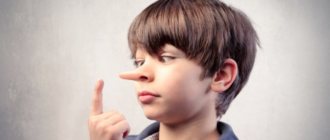The documents of the national educational initiative “Our New School” note that a support system for talented children should be created. Simultaneously with the implementation of the general education standard, an extensive system of searching for and supporting talented children, as well as accompanying them throughout the entire period of personal development, must be built.
It will be necessary to create both a special support system for mature, talented schoolchildren, and a general environment for the manifestation and development of the abilities of each child, stimulation and identification of the achievements of gifted children. In addition, it is indicated that within the framework of the system of supporting talented children, it is advisable to support a creative environment and provide the opportunity for self-realization for students of each secondary school. To do this, it is necessary to expand the system of Olympiads and competitions for schoolchildren, the practice of additional education, various kinds of student conferences and seminars, and work out mechanisms for taking into account individual achievements of students (student portfolios) during admission to universities.
Gifted children
Children may be gifted in one or more areas:
— Artistic
— Creative
— Intelligent
— Leadership
— Academic (scientific)
“From the first day of kindergarten, gifted children already know almost 60% of all educational material,” - US National Association of Gifted Children.
Eight intellectual spheres
Harvard professor Dr. Howard Gartner's theory of multiple intelligences proposes eight abilities that can be considered elements of human intelligence:
1. Bodily-kinesthetic: physical abilities, body dexterity, hand-eye coordination.
2. Intrapersonal: self-awareness or introspection of beliefs, emotions, goals, and motivations.
How to write a term paper on speech therapy
07.09.2010 243089
These guidelines are compiled to help students gain an understanding of the content and structure of coursework in speech therapy.
Logopedia of pedagogical science that studies anomalies of speech development with normal hearing, explores the manifestations, nature and mechanisms of speech disorders, develops the scientific basis for overcoming and preventing them means of special training and education.
The subject of speech therapy as a science is speech disorders and the process of training and education of persons with speech disorders.
The object of study is a person suffering from a speech disorder.
The main task of speech therapy as a science is the study, prevention and elimination of various types of speech disorders.
Coursework in speech therapy is a student's scientific and experimental research. This type of educational activity, provided for by the educational and professional program and curriculum, contributes to the acquisition of skills in working with literature, analyzing and summarizing literary sources in order to determine the range of insufficiently studied problems, determining the content and methods of experimental research, processing skills and qualitative analysis of the results obtained. The need to complete coursework in speech therapy is due to the updating of knowledge concerning the content, organization, principles, methods and techniques of speech therapy work.
As a rule, during their studies, students must write two term papers - theoretical and practical.
The first course work should be devoted to the analysis and synthesis of general and specialized literature on the chosen topic. Based on this analysis, it is necessary to justify and develop a method of ascertaining (diagnostic) experiment.
In the second course work, it is necessary to provide an analysis of the results obtained during the ascertaining experiment, as well as determine the directions and content of speech therapy work, and select adequate methods and techniques of correction.
So, let’s present the general requirements for the content and design of coursework in speech therapy.
The initial and most important stage of working on a course project is the choice of a topic, which is either proposed by the supervisor or chosen by the student independently from a list of topics that are consistent with the areas of scientific research of the department.
Each topic can be modified, considered in different aspects, but taking into account a theoretical and practical approach. Having chosen a topic, the student needs to think through in detail its specific content, areas of work, practical material, etc., which should be reflected both in the formulation of the topic and in the further construction of the study. It should be recalled that the chosen topic may not only have a purely theoretical orientation, for example: “Dysarthria. Characteristics of the defect”, “Classification of dysgraphia”, but also take into account the practical significance of the problem under consideration, for example: “Speech therapy work on speech correction for dysarthria”. It should also be taken into account that when formulating a topic, excessive detail should be avoided, for example: “Formation of prosodic components of speech in preschoolers of the sixth year of life attending a preschool institution for children with severe speech impairments.”
The course work includes such mandatory parts as: introduction, three chapters, conclusion, bibliography and appendix.
The text of the term paper begins with the title page . An example of its design can be seen here.
Then the content of the work is given, in which the names of chapters, paragraphs, and sections are formulated in strict accordance with the content of the thesis. An example of its design can be seen here.
In the text, each subsequent chapter and paragraph begins on a new page. At the end of each chapter, the materials are summarized and conclusions are formulated.
The introduction reveals the relevance of the problem under consideration in general and the topic being studied in particular; the problem, subject, object, and purpose of the study are defined. In accordance with the goal and hypothesis, objectives and a set of research methods aimed at achieving the objectives must be defined.
The relevance of the topic lies in reflecting the current level of pedagogical science and practice, meeting the requirements of novelty and usefulness.
When defining the research problem, it is important to indicate what practical tasks it will help to implement in training and educating people with speech pathology.
The object of research is understood as certain aspects of pedagogical reality, perceived through a system of theoretical and practical knowledge. The ultimate goal of any research is to improve this object.
The subject of research is some part, property, element of an object, i.e. the subject of research always indicates a specific aspect of the object that is to be studied and about which the researcher wants to gain new knowledge. An object is a part of an object.
You can give an example of the formulation of the object, subject and problem of research:
– The object of the study is the speech activity of preschool children with phonetic-phonemic speech disorders.
– The subject of the study is the features of intonation speech of children with phonetic-phonemic speech disorders.
– The research problem is to determine effective directions for speech therapy work on the formation of intonation expressiveness of speech in the system of correctional intervention.
The purpose of the study contributes to the specification of the object being studied. The goal of any research is to solve a specific problem. The goal is specified in tasks taking into account the subject of research.
The research objectives are formulated in a certain sequence, which determines the logic of the research. The research objectives are set on the basis of a theoretical analysis of the problem and an assessment of the state of its solution in practice.
The first chapter is an analysis of literary sources, which examines the state of this problem in historical and modern aspects, and presents the most important theoretical principles that formed the basis of the study.
When writing the first chapter, you should pay attention to the fact that the text of the course work must be written in a scientific style. When presenting scientific material, it is necessary to comply with the following requirements:
– Specificity – a review of only those sources that are necessary to disclose only a given topic or solve only a given problem;
– Clarity – which is characterized by semantic coherence and integrity of individual parts of the text;
– Logicality – which provides for a certain structure of presentation of the material;
– Reasoning – evidence of thoughts (why this and not otherwise);
– Precision of wording, excluding ambiguous interpretation of the authors’ statements.
A literary review of the state of the problem being studied should not be reduced to a consistent presentation of literary sources. It should present a generalized description of the literature: highlight the main directions (currents, concepts, points of view), analyze in detail and evaluate the most fundamental works of representatives of these directions.
When writing a work, the student must correctly use literary materials, make references to the authors and sources from which the results of scientific research are borrowed. Failure to provide required references will reduce your coursework grade.
As a rule, in coursework on speech therapy, references to literary sources are formatted as follows: the number of the cited source in the general list of references is placed in square brackets. For example: General speech underdevelopment is a speech pathology in which there is a persistent lag in the formation of all components of the language system: phonetics, vocabulary and grammar [17].
When using quotations, in square brackets, in addition to indicating the source number, the page number from which this excerpt is taken is indicated, for example: Speech rhythm is based on a physiological and intellectual basis, since, firstly, it is directly related to the rhythm of breathing. Secondly, being an element that performs a communicative function, “correlates with meaning, i.e. controlled intellectually” [23, P.40].
However, course work should not be of a purely abstract nature, so you should not abuse the unreasonable abundance of citations. Quoting should be logically justified, convincing and used only when really necessary.
In the second chapter , devoted to experimental research, the organization should be described and the program of the ascertaining experiment should be presented. The survey methodology, as a rule, consists of a description of several series of tasks, with detailed instructions, visual and lexical material, the procedure for completing tasks by experiment participants, and scoring criteria. This chapter also provides a qualitative and quantitative analysis of the results obtained.
When analyzing the results of an experiment, it is necessary to use a scoring system. Examples of various criteria for quantitative and qualitative assessment are presented in the following works:
– Glukhov V.P. Formation of coherent speech in preschool children with general speech underdevelopment. - M.: Arkti, 2002. - 144 p.
– Fotekova T.A. Test methodology for diagnosing oral speech of primary schoolchildren. - M.: Arkti, 2000. - 56 p.
– Levchenko I.Yu. Pathopsychology: Theory and practice. - M.: Academy, 2000. - 232 p.
In order to visually present the results obtained during the experimental study, it is recommended to use tables, graphs, diagrams, etc. Histograms can be used in a variety of ways - columnar, cylindrical, planar, volumetric, etc. An example of the design of tables, figures, and histograms can be found here.
The third chapter provides a rationale for the proposed methods and techniques and reveals the content of the main stages of correctional work.
The conclusion contains a summary of the material presented and the main conclusions formulated by the author.
The bibliography must contain at least 25 sources. The list includes bibliographic information about the sources used in preparing the work. An example of its design can be seen here.
In the application you can present bulky tables or illustrations, examination protocols, observation records, products of activity (drawings, written works of children), notes from speech therapy classes, etc.
The volume of one course work must be at least 30 pages of typewritten text.
In general, coursework in speech therapy is the basis for a future thesis, in which the study of the begun problem can be continued, but from the standpoint of a different approach or a comparative analysis of the disorders being studied in different age categories of people with different types of speech disorders.
The content and format of theses in speech therapy can be found here.
Literature:
1. How to write a term paper on speech therapy: Methodological recommendations. Educational and methodological manual / Comp. Artemova E.E., Tishina L.A. / Ed. Orlova O.S. – M.: MGOPU, 2008. – 35 p.
2. Research work of students in the system of higher professional pedagogical education (specialty 031800 - Speech therapy). Methodological recommendations for completing the thesis / Compiled by. L.V. Lopatina, V.I. Lipakova, G.G. Golubeva. - St. Petersburg: Publishing house of the Russian State Pedagogical University named after. A. I. Herzen, 2002. - 140 p.
Features of gifted children
Christopher Taibbi, an expert in gifted education, explains four critical differences between gifted and intelligent children. This is the first step in understanding how to help them succeed.
1. Smart kids work hard to achieve their goals. Gifted children may become bored with this process.
A smart child is a teacher's dream. He behaves well and works hard. As a result, he excels in class. In fact, smart students will succeed in a traditional academic setting because they are motivated primarily by grades and recognition.
This is a big problem for gifted children: they are not happy with grades or recognition. Gifted children often already know the answers without much effort, which can cause problems in the classroom. In search of inspiration and motivation, they often retreat into their inner worlds.
2. A smart child always knows the answer, a gifted child will always ask a question.
Smart children are excellent at processing and storing information. This fact, coupled with their work ethic, results in outstanding academic achievements. Gifted students often don't need much time to become familiar with the material.
As a result, gifted children are forced to sit for hours when they could simply “pass the test” and move on to the next task or subject.
Giftedness at school
Other types of giftedness are important for success in secondary school. There are children with a pronounced ability to learn, to assimilate the educational material offered to them. Moreover, they demonstrate this ability regardless of the difficulty of the subject and their own interests. This is the so-called academic giftedness . Children with this type of giftedness have a much easier school life, and their successes make their parents happy. And subsequently it is easier for them to get a good specialty and achieve success in their work. It is generally accepted that such children usually do not reach any special heights.
Other schoolchildren are distinguished by special intellectual talent: the ability to think, compare, highlight the main thing, draw independent conclusions, make predictions, etc. But, unfortunately, the success of such children most often depends on their attitude, interest in the subject and its teacher. They may study unevenly (either “five” or “two”): brilliantly in one subject and “so-so” in another.
A special type of giftedness is creative talent . This does not only mean abilities in visual, musical or literary activities. Creative talent is, first of all, a non-standard perception of the world, originality of thinking, and a rich emotional life.
Development of gifted children
Are you wondering how to identify a gifted child? Here are 15 signs that will help you with this:
1. Little teachers
Gifted children often acquire knowledge much faster than average. Often language skills seem more natural to them. A broad vocabulary and a willingness to explain are two ways a child can demonstrate these skills.
2. They identify patterns.
Identifying patterns such as puzzles, signs or even when mommy comes home is not something common among young children.
What is childhood giftedness?
The expression “gifted children” is used very widely. If a child shows unusual success in learning or creative activities, significantly outperforming his peers, he may be called gifted. This definition is most widely accepted in American psychology and pedagogy, and is now becoming widespread among us.
There are reasons for this, in particular, in relation to the mental manifestations of children. If a child, other things being equal, has an unusually rapid rate of mental development, as well as clear achievements in a particular activity, it is right to recognize him as extraordinary. And therefore it needs an appropriate approach. But can we consider that such a child already has sufficient prerequisites for the further growth of his special capabilities, i.e. in order to become a gifted adult over time? Apparently, this cannot be said for many such children. In a narrower and stricter sense, the concept of “giftedness” in relation to children should have been applied only to those cases where the outstanding properties of the child are presented as a real guarantee of his future capabilities.
Identification of gifted children
4. They are extraordinarily talented
“Gifted” is just another word for “exceptionally talented.” Some children show their natural talent in sports, science, and art, which is certainly a sign of gifted intelligence.
5. They are interested in adult company and older children.
Gifted children, due to their advanced intelligence, have difficulty communicating with peers. They may be misunderstood, or they may simply be bored. Thus, they are more likely to be seen among older children, parents, teachers, coaches, and other adults.
6. They are always attentive
So there's a caveat here. Most gifted children have an exceptional ability to focus on things that interest them.
...and idolized
Sergei Prokofiev was an adored child in the family; his parents became his first teachers in Russian, arithmetic, geography, and history. By the age of 6, he had already written three plays.
Photo: Gettyimages
Charles Gounod was multi-talented: he composed sacred music, drew beautifully and wrote talentedly. His parents were also extraordinary people and supported their son.
Photo: Gettyimages
Specifically
Gifted child in class
9. Leadership qualities
Because of their maturity and uncanny ability to solve problems and think outside the box, gifted children often show a penchant for leadership. Of course, these skills are even stronger when the child is in a specific, desired environment.
10. They don't need directions
While most children wait for a parent or teacher to tell them how best to do something, gifted children are eager to get started and ask questions later.
They were considered stupid...
Neighbors, acquaintances, and teachers considered Thomas Alva Edison He was absent-minded, studied poorly, and also had hearing problems. His parents had to pick him up from school.
Photo: Gettyimages
Ilya Mechnikov was known as a loser as a child and endured the ridicule of his brothers and their contemptuous attitude. The only thing where he was head and shoulders above everyone else was botany. He paid his brothers 2 kopecks just to listen to him.
Photo: Gettyimages
Forms of manifestation of children's talent
Giftedness that manifests itself clearly and clearly in a child’s activities is called overt . Veiled, disguised - called hidden or latent giftedness. There is another, very similar gradation - actual and potential giftedness. Manifested, obvious talent, noticed by psychologists, teachers, and parents, is called actual. Children who demonstrate actual giftedness are often called not gifted, but talented children. And, on the contrary, giftedness, which represents only certain mental capabilities (potential) for high achievements, but cannot be realized at the moment in activity due to their functional insufficiency, is called potential. The facts of the existence of actual and potential, obvious and hidden, early and late giftedness emphasize the complexity and importance of the problem. What signs, personality traits, character traits, characteristics of behavior and activity can indicate to an adult that a child may become an outstanding scientist, artist, or leader in the future? The answer to this complex question cannot be simple. Scientists have already discovered a number of patterns that make it possible to predict a child’s future, but there is still a long way to go to an algorithm for constructing reliable, well-founded forecasts. World pedagogical experience shows that often faith in the capabilities of a student, multiplied by the skills of parents and teachers, is capable of creating pedagogical miracles. In life, it often turns out that what is important is not even what nature has given to a person, but what he himself has been able to do with the gift that he has. This problem is related to another, no less important. The mental potential of a person is not static, it exists only in dynamics and is constantly changing. Therefore, many scientists devoted their research to studying human productivity at various periods of his life.
Definition of giftedness and its features
Each childhood age stage is distinguished by certain conditions for the formation of abilities. But also with age, children lose their talent if they do not begin to develop it. Therefore, if you do not see a special child in a timely manner, then you may not have time to help him develop the ability that nature has given.
Many people may confuse two completely different terms - giftedness and training. This is a rather serious mistake, since a gifted child, if he begins to develop his own abilities in a timely manner, will be able to achieve much more than children who are simply well trained.











